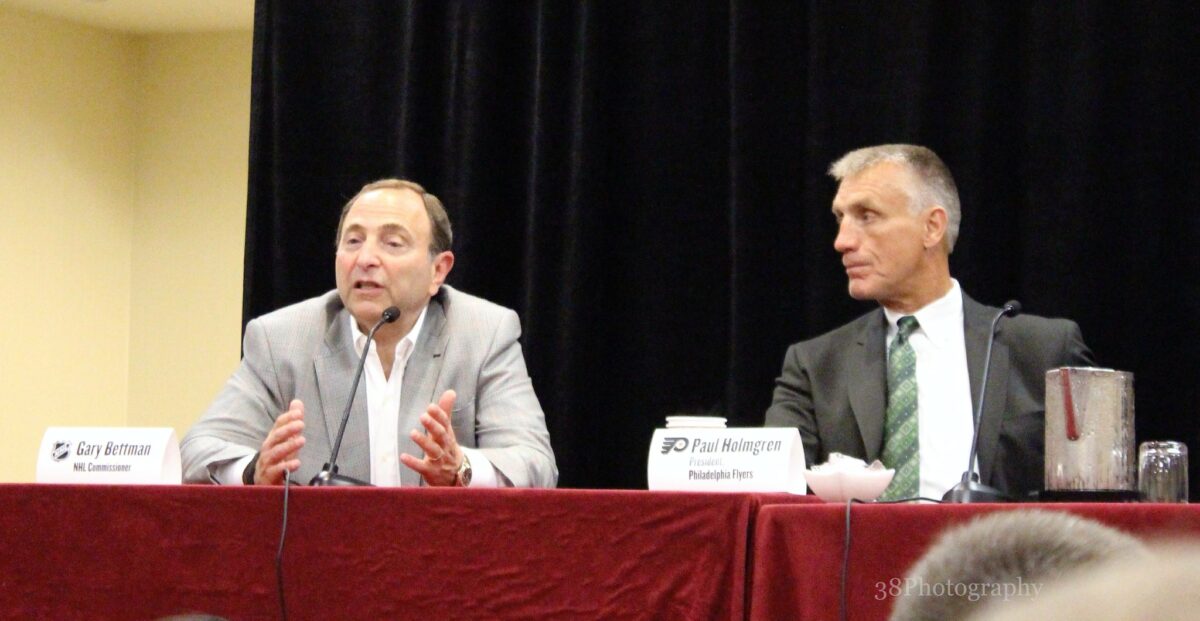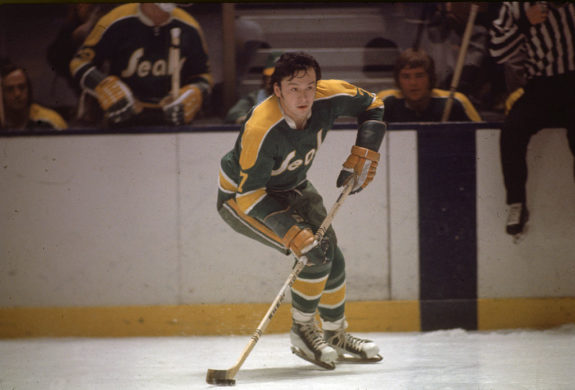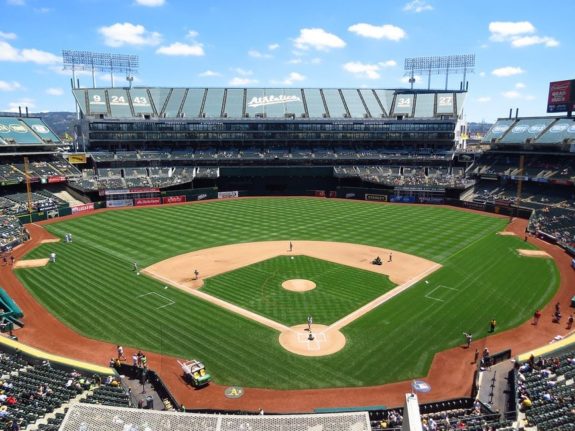The Arizona Coyotes have been in the news recently for all the wrong reasons. The city of Tempe, Arizona, voted on three proposals that would help develop an arena and entertainment district in a special election, but all three proposals were denied by the citizens. With the new arena getting rejected, the Coyotes and their future in Arizona is in jeopardy, with the next few years, in particular, bringing a lot of uncertainty about where they’ll play and if they’ll find a long-term home.
Related: 7 Cities That Make Sense for NHL Relocation
Major League Baseball’s (MLB) Oakland Athletics have made similar headlines recently. After years of failing to get a new ballpark, owner Josh Fisher and the team altogether gave up on the team and have been actively trying to lose. At the same time, they are trying to have a ballpark built in Las Vegas with the hopes of relocating, making the situation not only dramatic but pitiful, especially for the fans of the team, who, like the Coyotes, are thrown into the middle of a mess.
The recent news for both teams has made it easy for fans to point out the flaws in small-market teams or teams in non-traditional markets. The often-used phrases are that sports can’t thrive in some cities, and for the NHL, teams in the south, west, or in the Coyotes’ case, the southwest, aren’t suited for hockey. Commissioner Gary Bettman’s care for the Coyotes leaves fans frustrated, especially since he’s given them a longer leash than most teams would receive, making him a frustrating and resented commissioner at times.

Why does he care about the expansion and small market teams if they aren’t working out and don’t appear like they will in the near future? The answer is that historically, small-market teams in all sports have not only succeeded but have often exceeded expectations when they won. Organizations in these markets have a low floor but a ceiling when they are successful, which makes them a worthwhile investment.
The A’s History of Boom & Bust
The history of the Athletics as a franchise, even going back to their years in Philadelphia, was filled with years of glory but also some of the worst seasons in baseball history. They won three World Series titles from 1910 to 1913 and appeared in the World Series in 1914, then finished in last place seven years in a row (with a winning percentage of .257 in 1919, one of the worst of all time). They won back-to-back titles in 1929 and 1930 but then became a perennial cellar dweller until they moved to Kansas City and eventually Oakland.
Even in Oakland, they didn’t sell out despite winning three World Series titles in a row from 1972-74. Their season attendance only surpassed 1 million twice in the decade despite being the best team in the league. They were successful in spite of their owner Charles Finley, who interestingly enough also owned the California Seals in the NHL, and not because of him. Finley is considered one of the worst owners in sports history, driving both the A’s and the Seals into bankruptcy before selling both teams at the end of the decade. His baseball team was successful at a time when they could draft well but not lose their players to free agency, allowing them to build a great roster without spending.

The one time that the A’s spent and invested in the team while in Oakland was in the late 1980s. The Haas family, who bought the team from Finley, cared about the team and wanted to put together a winning organization, and the entire Bay Area bought into them. Not only did the A’s win, appearing in three consecutive World Series and winning one in 1989, but they were one of the best-selling teams in the sport. Their five most attended seasons were from 1988-92, and in 1990, their attendance was second-best in the league.
This is the same city that is regarded as a small market and can’t attract fans these days, but back then, they were the hot ticket. Oakland Coliseum, regarded as one of the worst ballparks these days, was the place to be. While renovations to the park have made it a less desirable place in recent years, a competitive team sold well.

Now, they’ve given up on the idea of being competitive. They are actively trying to lose, and on top of that, Fisher, who currently owns the team, is refusing to invest in the ballpark, making it more difficult for fans to attend games and announcers to work them. The relationship with Fisher and Oakland, which has refused to give in to his demands for a new ballpark, has become a bitter one. The fans, many of whom fell in love with the team in the late 1980s, are the ones that suffer the most, and a relocation to Las Vegas will be all the more devastating. Similarly, the Coyotes relocating as the Hartford Whalers, Quebec Nordiques, and Montreal Expos did would be a dagger to the hearts of the fans.
The Coyotes Made This Undesirable
The Coyotes’ move from Winnipeg to Arizona was part of Bettman’s vision for a thriving league. The game needed to grow, and the last frontier for the NHL, when he became commissioner in the early 1990s, was the south of the United States. The idea of putting a team in the Phoenix area, which is one of the most populated in the country, was a good one and made sense. The problem is that the team, along with any club relocating to a new city, is they need to get off the ground running and be competitive immediately. The Vegas Golden Knights reached the Stanley Cup Final in their inaugural season, and while they haven’t been as good since that run, the energy and enthusiasm from the first year brought in fans that are there to stay.
The Coyotes had strong attendance their first few seasons but could never put together a good enough team to maintain a strong enough fanbase. From the 2000-01 season until the 2009-10 season, they only made the playoffs once, and being a constant last-place team made it hard for the fans and the city to buy in. To make matters worse, the greater Phoenix area had a lot of entertainment, and if the Coyotes weren’t winning, there were a lot of things the fans could do instead. The sports scene alone has college football in the fall, pro football in the fall and winter, and basketball throughout the course of the NHL season, making it easy to watch another team if the NHL team isn’t great.
The one time the Coyotes were good and looked like a Stanley Cup contender was in the 2011-12 season. Ray Whitney, Radim Vrbata, and Shane Doan led the offense with a combined 81 goals and 108 assists, while Keith Yandle led the defense with 11 goals and 32 assists while also contributing 4.3 defensive point shares. In the net, Mike Smith had a phenomenal season with a .930 save percentage (SV%) and a 2.21 goals-against average (GAA) on 2066 shots. The Coyotes not only won the Pacific Division with a 42-27-13 but reached the Western Conference Final.

The result was a city and a state that was fully invested in the team. Gila River Arena (called Jobing.com Arena at the time) was sold out and would often shake when the team scored. That one year was proof to Bettman and the league as a whole that hockey can work in the desert.
Unfortunately, the Coyotes haven’t been competitive, with only one playoff appearance since. After making the playoffs in 2019-20 and nearly missing the playoffs the next year, they were a franchise at crossroads. Either they could try to buy in and make a push to be competitive or blow up the roster with the hope of rebuilding from the ground up. They chose the latter, which, in the long run, seems like the best path to winning a Stanley Cup, but it comes with a cost. In the Coyotes’ case, that cost is a drop in attendance and interest in the organization from the public.
Not only have the Coyotes been losing, but they’ve taken a unique path to tearing down their roster. In the 2021 offseason, they allowed both their starting goaltenders, Darcy Kuemper and Adin Hill, to leave in free agency while they traded Oliver Ekman Larsson to the Vancouver Canucks. In the past two trade deadlines, they have moved some of the best players in their primes, including Shayne Gostisbehere and Jakob Chychrun, in exchange for future draft selections. They’ve also taken on salary cap space from other teams to accumulate more draft picks while keeping the players they acquired in the deal on long-term injured reserve. The Coyotes’ moves have signaled that they aren’t trying to win now or anytime soon.

While in the long run, the Coyotes can turn things around and use the surplus of draft assets to build a contender, the message being sent to the fans is that this team doesn’t care, at least not yet. With that in mind, it’s hard for them to buy in, quite literally, to a team that has become undesirable, winning only 53 games in the last two years.
Small Market Teams Can Exceed Expectations
The Coyotes’ recent fallout comes at a time when the NHL should be celebrating the growth of the game. All four teams that remain in the Stanley Cup Playoffs are in southern, non-traditional markets for hockey. The Carolina Hurricanes and Dallas Stars relocated from Hartford and St. Paul, while the Florida Panthers and the Golden Knights are two of the recent expansion franchise. All four teams have not only sold out their home games this year but have brought energy and enthusiasm for the game to their cities and the regions altogether.
The Tampa Bay Lightning, who also play in the south, have become a model franchise in the NHL. They won the Stanley Cup in 2020 and 2021 while reaching the Final in 2022 and have also grown one of the biggest hockey fanbases in the past 30 years. They sell out every home game at Amalie Arena and have been the team to watch in the area, even with the Rays in MLB playing well and the Buccaneers winning a Super Bowl in 2021. The Lightning have excelled under Bettman both on and off the ice and have paved the way for other expansion teams.

The successful teams in the south have not only done well but have become the hot ticket in their cities. The advantage of these locations is that they are big enough to gain a large following when the team is doing well, and plenty of people can and will buy into them. There’s a lot to do in the southern cities, especially in the summer, but when there’s a Cup contender in town, it becomes the popular attraction.
What Teams Can Learn From The Coyotes & A’s
If a franchise can put together a competitive team, their fans will show up. When a team is willing to invest in the roster and the city, the fans not only follow, but they often make home games the place to be in the area. The one time the A’s ownership cared about the team, they were the most popular in the sport, and similarly, the great NHL teams ended up selling out regardless of the market they were in.
The A’s are trying to move to Las Vegas, and the thought is that the move will change everything. However, if they don’t win, they’ll struggle to sell seats like they currently do in Oakland. The Golden Knights are seen as proof that the city is a sports town and will bring in fans regardless of how the team plays. However, the Golden Knights haven’t seen what attendance looks like when they are a losing organization, something the A’s will likely be if they end up moving.
The Coyotes’ owner, Alex Meruelo, is worth $2 billion, and the Coyotes are valued at $450 million, according to Forbes. If he puts in the money to not only build the arena but make the team competitive, then fans will show up as well. Granted, the recent proposition for Tempe signaled that the arena would be mostly privately funded, and similarly, it’s hard to spend on a winning team in the NHL, which has a salary cap.
However, recent history has suggested that Meruelo is more interested in cutting corners both on and off the ice. In Dec. 2021, the team was almost locked out of Gila River Arena after not paying city and state taxes. While the Coyotes paid them shortly after the threat, the missed deadline has been seared into the minds of the voters in Tempe. On the ice, the Coyotes’ final salary cap hit was $66.8 million, leaving them $15.6 million that they could’ve spent but didn’t. Meruelo says he’s willing to commit to building a winning and successful team, but his recent actions have suggested otherwise.

There’s a saying in sports that “winning fixes everything,” and to a point, it’s true. However, along with winning, the team needs to show their fans that they care. The Coyotes have done so to an extent, but to save the team, it’s about a full commitment from Meruelo, the front offices, the coaches, the players, and everything in between. Bettman has gone to far measures to keep the team in Arizona, but now, the Coyotes are in their final hour.
